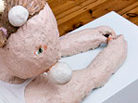Poland — Germany 4:6 — group exhibition of Polish and German artists

Artists:
Marcin Berdyszak
Jacek Jagielski
Kamil Kuskowski
Leszek Lewandowski
Wiebke Bartsch
Jupp Ernst
Carsten Gliese
Anja Jensen
Dietmar Schmale
Sabine Swoboda
Originators of the exibition: Leszek Lewandowski and Prof. Marcin Berdyszak
Curator: Marta Raczek
Coordinator (Germany): Martin Rehkopp

‘Poland — Germany 4:6’ catalogue summary of exhibition The publication features works by Polish and German artists who participated in the exhibition “Poland — Germany 4:6”: Marcin Berdyszak, Jacek Jagielski, Kamil...

The exhibition ‘Poland —Germany 4:6’ was thought as an artistic dialogue with which the history and the present day of Polish-German relations can be told. The presentation aims at paying attention to multidimensional character of the neighbouring coexistence of both nations, history of which has been marked both with alliances, like in the era of Otto III and Bolesław Chrobry, and tragic moments, including especially the period of World War Two. The exhibition is held on the occasion of the seventieth anniversary of its outbreak. The title of the exhibition itself, which refers to the fact that the Polish football team could never defeat the German team, suggests that the exhibition speaks not only about great history, but also about some phenomena from the area of pop culture and everyday life. There can be very many points of departure: political history, stereotypes in mutual seeing of both nations, the problem of mass migration from Poland to Germany in the eighties, as well as periodical but lucrative seasonal labour trips, and smuggling which bloomed at certain time (the latter was mocked in a cabaret song by Janusz Rewiński, ‘Zigaretten nach Berlin, a jaded customs officer is sleeping — it won’t get back — Kryśka is speeding her small car, we are smuggling like in a dream — it won’t get back…’). Today in borderland towns Germans visit Polish dentists and hairdressers, and quite recently even pubs on weekends, where they can smoke still freely, contrary to what’s at theirs’. The exhibition aims also at the deconstruction of the image of a German and a Pole, fixed in both cultures, especially in popular cinema, televised series, songs or novels.
The place of its presentation, Silesia, is also an important context of the exhibition. Many Germanic expressions survived in Silesian dialect; Silesian songs resemble German drinking songs, and the idea of folk festivities is not foreign both to Silesians and Germans. In spite of these convergences, these two cultures belong to different orders, and simultaneously preserve in themselves things that can be read as a specific common value.
The last topic worthy of attention is the artistic dialogue which individual artists can enter, confirming for another time that art knows neither bounds nor passports, and that similar problems or formal solutions are present at both sides of the border.
Rivalry is not the idea of the exhibition, as could suggest the title drawn from football phraseology, but the play between meanings, the clash between different views, and also showing various attitudes towards art, originated from different traditions, both social and artistic. The title ‘Poland — Germany 4:6’ is a good metaphor which refers both to the official history of Polish-German relations, and to the neighbourly contacts on the most basic, everyday level as well. The reference to football indicates that that play is not only a sport rivalry, but also a collective work, within the framework of which only a collaborating team is able to win. The artists taking part in the exhibition refer to the Polish-German relations on many levels, showing them both in universal optics and in the context of messages transmitted within the framework of pop culture. In the year of the celebrations of the seventieth anniversary of the outbreak of World War Two the exhibition becomes a necessary and important voice that summarises the last fifty years of Polish-German relations, escaping categorical opinions and stereotypical perspectives. For centuries art has been a kind of lens which focused the most important social and cultural transformations. The exhibition can be a mirror for both nations, encouraging both to make a thorough analysis of the past, and to make a courageous insight in the future of mutual relations, and in working out a new formula for them.
Curator: Marta Raczek








